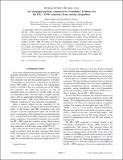Are entangled particles connected by wormholes? Evidence for the ER = EPR conjecture from entropy inequalities
Author(s)
Gharibyan, Hrant; Penna, Robert
DownloadGharibyan-2014-Are entangled particles connected.pdf (192.7Kb)
PUBLISHER_POLICY
Publisher Policy
Article is made available in accordance with the publisher's policy and may be subject to US copyright law. Please refer to the publisher's site for terms of use.
Terms of use
Metadata
Show full item recordAbstract
If spacetime is built out of quantum bits, does the shape of space depend on how the bits are entangled? The ER = EPR conjecture relates the entanglement entropy of a collection of black holes to the cross sectional area of Einstein-Rosen (ER) bridges (or wormholes) connecting them. We show that the geometrical entropy of classical ER bridges satisfies the subadditivity, triangle, strong subadditivity, and Cadney-Linden-Winter inequalities. These are nontrivial properties of entanglement entropy, so this is evidence for ER = EPR. We further show that the entanglement entropy associated with classical ER bridges has nonpositive tripartite information. This is not a property of entanglement entropy, in general. For example, the entangled four qubit pure state |GHZ[subscript 4]⟩ = (|0000⟩ + |1111⟩)/√2 has positive tripartite information, so this state cannot be described by a classical ER bridge. Large black holes with massive amounts of entanglement between them can fail to have a classical ER bridge if they are built out of |GHZ[subscript 4]⟩ states. States with nonpositive tripartite information are called monogamous. We conclude that classical ER bridges require monogamous EPR correlations.
Date issued
2014-03Department
Massachusetts Institute of Technology. Department of Physics; MIT Kavli Institute for Astrophysics and Space ResearchJournal
Physical Review D
Publisher
American Physical Society
Citation
Gharibyan, Hrant, and Robert F. Penna. “Are Entangled Particles Connected by Wormholes? Evidence for the ER = EPR Conjecture from Entropy Inequalities.” Phys. Rev. D 89, no. 6 (March 2014). © 2014 American Physical Society
Version: Final published version
ISSN
1550-7998
1550-2368